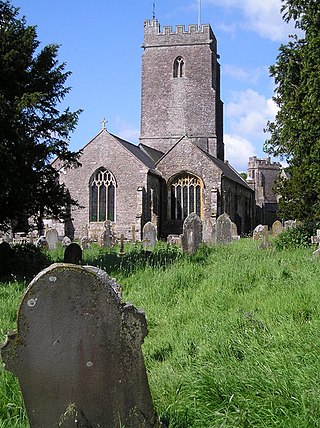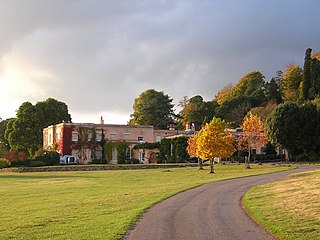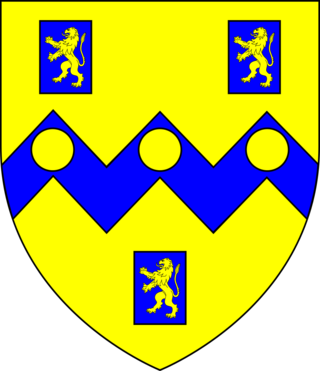The Grand Western Canal ran between Taunton in Somerset and Tiverton in Devon in the United Kingdom. The canal had its origins in various plans, going back to 1796, to link the Bristol Channel and the English Channel by a canal, bypassing Lands End. An additional purpose of the canal was the supply of limestone and coal to lime kilns along with the removal of the resulting quicklime, which was used as a fertiliser and for building houses. This intended canal-link was never completed as planned, as the coming of the railways removed the need for it.

Friends of Friendless Churches (FoFC) is a registered charity formed in 1957, active in England and Wales, which campaigns for and rescues redundant historic places of worship threatened by demolition, decay, or inappropriate conversion. As of April 2021, the charity owns 58 redundant churches or chapels, 29 of which are in England, and 29 in Wales.

Halberton is a village and civil parish in Devon, England. It is situated between the historic market towns of Tiverton and Cullompton. The Grand Western Canal runs around to the north and west of the village.

Burlescombe is a village and civil parish in the Mid Devon district of Devon, England. The parish is surrounded, clockwise from the north, by the parishes of Holcombe Rogus, Culmstock, Uffculme, Halberton and Sampford Peverell. According to the 2001 census it had a population of 911. The village is about 5 miles (8.0 km) south west of Wellington in Somerset. The ruins of the 12th century Canonsleigh Abbey are nearby. Burlescombe is part of the electoral ward of Canonsleigh. The population of this ward was 3,218 at the 2011 Census.

Holcombe Rogus is a village, civil parish and ecclesiastical parish in the English county of Devon. In 2001 the population of the parish was 503.

Sampford Peverell is a village and civil parish in Mid-Devon, England. An old Saxon settlement, it was called Sanforda in the 1086 Domesday Book. Its current name reflects its inclusion in the Honour of Peverel, the lands of William Peverel and his family. His great-grandson, Hugh Peverell, is buried in the village church of St John the Baptist. The Grand Western Canal cuts through the village.

Killerton is an 18th-century house in Broadclyst, Exeter, Devon, England, which, with its hillside garden and estate, has been owned by the National Trust since 1944 and is open to the public. The National Trust displays the house as a comfortable home. On display in the house is a collection of 18th- to 20th-century costumes, originally known as the Paulise de Bush collection, shown in period rooms.

Uffculme is a village and civil parish located in the Mid Devon district, of Devon, England. Situated in the Blackdown Hills on the B3440, close to the M5 motorway and the Bristol–Exeter railway line, near Cullompton, Uffculme is on the upper reaches of the River Culm. The population of the parish, according to a 2020 estimate, is 3,090. It is surrounded, clockwise from the north, by the parishes of Culmstock, Hemyock, Sheldon, Kentisbeare, Cullompton, Willand, Halberton and Burlescombe.

Wonford is a former village, manor and ecclesiastical parish in Devon, England, now a part of the City of Exeter. The 13th century St Loye's Chapel situated within the parish now gives its name to the surrounding location. Wonford is situated next to the former parish of Heavitree, now both covered by the suburbs of Exeter.

Canonsleigh Abbey was an Augustinian priory in the parish of Burlescombe, Devon.

Luppitt is a village and civil parish in East Devon situated about 4 miles (6 km) due north of Honiton.
Charles Wilmot, 1st Viscount Wilmot of Athlone was an English soldier active in Ireland.

Ayshford Chapel is a former private chapel in the village of Ayshford, in the parish of Burlescombe, Devon, England. It is recorded in the National Heritage List for England as a designated Grade I listed building, and is under the care of the Friends of Friendless Churches. It is situated immediately to the south of the manor house of Ayshford Court, and to the north of the Grand Western Canal.
Meshaw is a village and civil parish in the North Devon district of Devon, England. Its nearest town is South Molton, which lies approximately 5.9 miles (9.5 km) north-west from the village. The village lies just off the B3137 road. Meshaw also lies on the same B3137 road as Witheridge which is approximately 4.7 miles south-east of the village. In 2001 the population of the civil parish of Meshaw was 151.
The hundred of Bampton was the name of one of thirty two ancient administrative units of Devon, England.

Forde House, now known as Old Forde House, is a Grade I listed former manor house dating in back to c. 1550 in Newton Abbot, Devon, England. The building was substantially enlarged c. 1610 and is noted for its fine 17th-century wood-carving and plasterwork. Once the manor house of the parish of Wolborough, it is now absorbed into a suburb of Newton Abbot. The south front faces Torquay Road across the house's front lawn. The building was purchased in 1978 by Teignbridge District Council which then built itself a modern headquarters in the grounds which opened in 1987. The council offices now take the name Forde House, and the old mansion is known as Old Forde House.

The Manor of Molland was a medieval manor in North Devon, England. It was largely co-terminous with the existing parish of Molland, in which is situated the village of Molland. More accurately it consisted from the earliest times of two separate manors, held from separate overlords, later known as Molland-Bottreaux and Molland-Champson.

Denys Rolle (1614–1638) of Bicton and Stevenstone in Devon was Sheriff of Devon in 1636. He was one of the biographer John Prince's Worthies of Devon.

Sir Robert Cary of Cockington, Devon, was twelve times Member of Parliament for Devon, in 1407, 1410, 1411, May 1413, April 1414, Mar. 1416, 1417, 1419, May 1421, 1422, 1425 and 1426. Much of his later life was devoted to regaining the many estates and other landholdings forfeited to the crown following his father's attainder in 1388. He was an esquire in the households of King Richard II (1377–1399) and of the latter's half-brother John Holland, 1st Duke of Exeter.

Tiverton Cemetery is the burial ground for the town of Tiverton in Devon. The cemetery covers eight acres and is owned and maintained by Mid Devon Council.



















